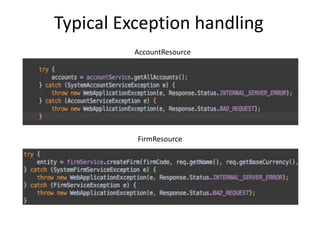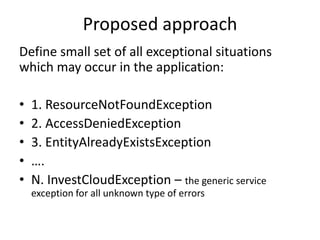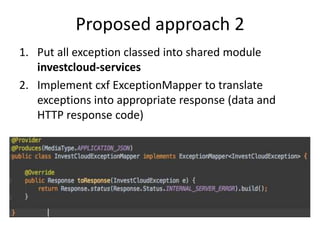Errorhandlingppt
- 1. Typical ŌĆ£ExceptionŌĆØ in InvestCloud project
- 2. LetŌĆÖs do the numbers 1. Typical Exception class lines count ŌĆō 28 2. 86classes extends Exception in the project codebase 3. 28 * 86 = ~2400lines of identical code What is the reason to have and maintain this code?
- 4. Exception handling (part 2) (AccountResource again)
- 5. LetŌĆÖs do the numbers 2 $ grep -c -R --include=*.java ".*} catch .*ServiceException" * > out && awk -F : '{total += $2} END { print "Total:", total }' out 1. *ServiceException catch statements total count ŌĆō 320 2. *PersistenceException catch statements count ŌĆō 248 3. Typical handler code rows count ŌĆō 3 4. Total handlers code rows count ŌĆō 320+248 * 3 = ~1700 Total: 1700 + 2400 = 4100 lines of code
- 6. Proposed approach Define small set of all exceptional situations which may occur in the application: ŌĆó 1. ResourceNotFoundException ŌĆó 2. AccessDeniedException ŌĆó 3. EntityAlreadyExistsException ŌĆó ŌĆ”. ŌĆó N. InvestCloudException ŌĆō the generic service exception for all unknown type of errors
- 7. Proposed approach 2 1. Put all exception classed into shared module investcloud-services 2. Implement cxf ExceptionMapper to translate exceptions into appropriate response (data and HTTP response code)
- 8. Your thoughts please PROS: 1. Dramatically reduced exception and exception codebase 2. Well defined set of exceptional situations 3. Single point of error handling (better testability) 4. Cleaning up endpoint classes from error prone code 5. All of that makes us more productive








